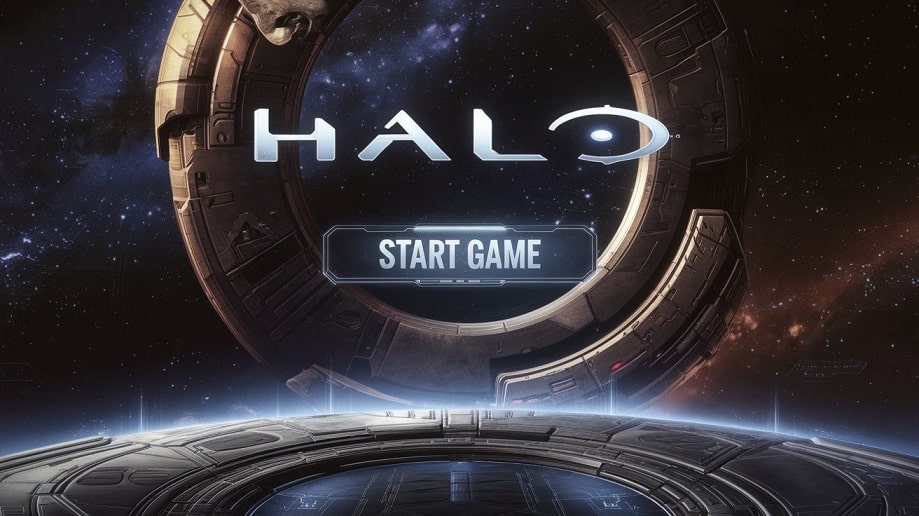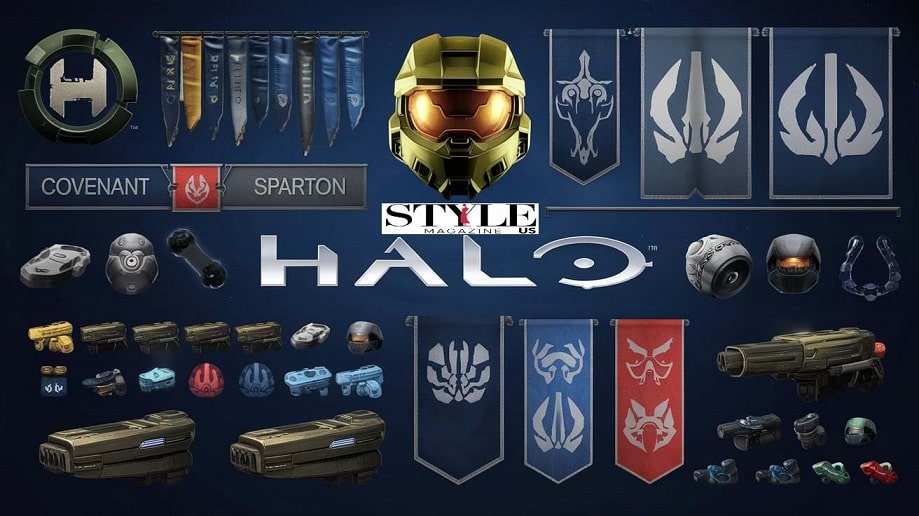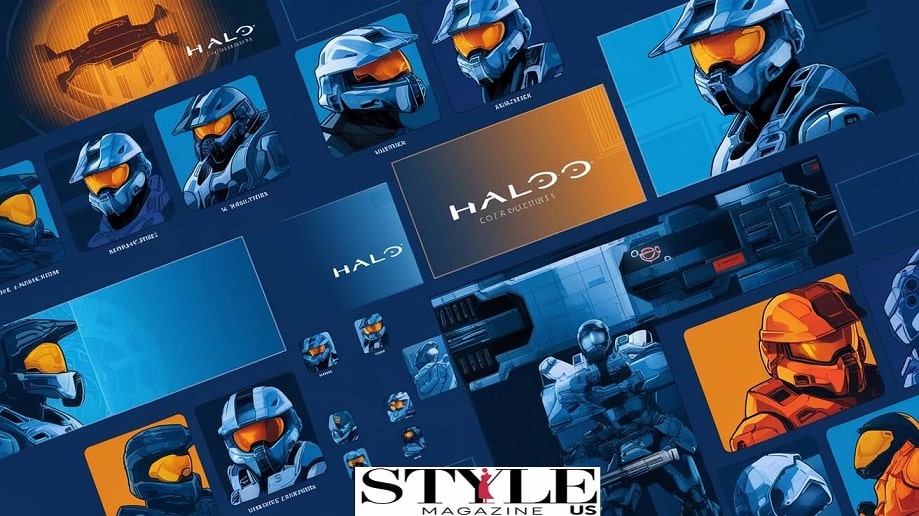The Halo franchise has left an indelible mark on the gaming landscape, with its iconic visuals playing a crucial role in its enduring legacy. From the moment Halo: Combat Evolved hit shelves in 2001 to the release of Halo (2003), the series has captivated players with its immersive experience and distinctive visual identity. This article delves into the rich tapestry of Halo (2003) game icons and banners that have defined the Halo universe, exploring their evolution, impact, and the cultural legacy they’ve created.
The Birth of Legends: Key Icons from Halo (2003)
Let’s get started.
Master Chief’s Helmet: The Face of Humanity’s Hope
At the heart of Halo’s visual lexicon stands the Master Chief’s helmet, an emblem of heroism and resilience. This iconic piece of imagery has undergone subtle yet significant changes since its debut in Halo: Combat Evolved (2001). By the time Halo (2003) rolled around, the helmet had been refined, its minimalist design striking a perfect balance between futuristic military tone and approachability.
The helmet’s evolution reflects the character’s journey:
- Initial design: Rugged and utilitarian
- Halo (2003) iteration: Sleeker, with enhanced detail
- Symbolic meaning: Hope, strength, and humanity’s last stand
The impact of Master Chief’s helmet on gaming culture cannot be overstated. It has become synonymous with the franchise, adorning everything from game covers to merchandise, cementing its place in the pantheon of gaming iconography.
The Halo Ring: A Cosmic Enigma
The Halo ring itself is perhaps the most significant symbol in the entire franchise. This massive, mysterious structure serves as both setting and plot device, its circular form a perfect representation of the game’s blend of sci-fi universe and ancient mystery.
“When you first saw Halo, were you blinded by its majesty?” – The Prophet of Regret
The ring’s visual representation has been crucial in:
- Level design: Shaping the game’s unique environments
- Storytelling: Serving as a constant reminder of the overarching narrative
- Marketing: Providing a instantly recognizable symbol for the franchise
UNSC Logo: Humanity’s Shield

The UNSC logo (United Nations Space Command) stands as a testament to humanity’s resolve in the face of alien threats. Its design embodies the futuristic military tone that permeates the Halo universe.
| Element | Symbolism |
|---|---|
| Eagle | Strength and freedom |
| Globe | Unity of Earth |
| Stars | Reach for the cosmos |
This logo’s presence throughout the game reinforces the player’s role as a defender of humanity, enhancing the overall immersive experience.
Banners of War: Setting the Stage for Epic Battles
Master Chief in Action: Capturing the Hero’s Journey
Promotional banners featuring Master Chief have been instrumental in setting player expectations and building excitement. These dynamic visuals often showcase:
- Master Chief in mid-combat poses
- Iconic weapons like the energy sword or assault rifle
- Dramatic backgrounds featuring Halo environments
These banners not only serve as powerful marketing tools but also as extensions of the game’s narrative, offering glimpses into the epic battles awaiting players.
Covenant vs. UNSC: Visualizing the Galactic Conflict
The contrast between human and alien aesthetics is vividly captured in banners depicting the Covenant vs. UNSC conflict. These visuals encapsulate the core tension of the Halo storyline, often featuring:
- Sleek, purple Covenant technology against rugged UNSC hardware
- Alien landscapes juxtaposed with human colonies
- The imposing silhouettes of Covenant Elites facing off against Spartans
Halo Environmental Banners: Alien Worlds Come Alive
Environmental banners in Halo showcase the diverse and breathtaking settings players will explore. From the lush forests of Installation 04 to the stark beauty of High Charity, these visuals:
- Hint at the scale and variety of gameplay environments
- Reinforce the sci-fi universe aesthetic
- Spark players’ curiosity and desire to explore
Icons as Gameplay Enhancers: Form Meets Function
HUD and UI: Immersion Through Information
The HUD (Heads-Up Display) in Halo games is a masterclass in functional design. It provides crucial information without breaking immersion, featuring:
- Shield and health indicators
- Ammunition counters
- Motion tracker
The evolution of the HUD from Halo: Combat Evolved (2001) to Halo (2003) showcases a refinement in design, prioritizing clarity and quick information access.
Weapon Icons: At-a-Glance Arsenal Management
Weapon icons in Halo are designed for instant recognition, allowing players to make split-second decisions in the heat of battle. Notable examples include:
- The assault rifle icon: A symbol of reliability and versatility
- The energy sword icon: Representing Covenant technology and close-quarters combat
These icons not only serve a practical purpose but also contribute to the game’s overall aesthetic, reinforcing the futuristic military tone.
Vehicle Icons: From Warthog to Banshee
Vehicle icons in Halo games offer quick visual cues for players, enhancing gameplay navigation and strategic decision-making. Each icon is carefully crafted to reflect the vehicle’s characteristics:
- Warthog: Rugged and reliable
- Ghost: Sleek and agile
- Banshee: Alien and menacing
The Art of Storytelling Through Visuals
Icons as Narrative Devices
In Halo, icons serve as more than just UI elements; they’re integral to the storytelling process. For instance:
- The changing UNSC logo throughout the series reflects the evolving state of humanity
- Covenant symbols provide insight into their hierarchical society and religious beliefs
- Forerunner glyphs hint at ancient mysteries and advanced technology
Environmental Storytelling via Banners and Symbols
The Halo universe is rich with environmental banners and symbols that add depth to the game world:
- UNSC propaganda posters in human colonies
- Covenant religious symbols in their structures
- Ancient Forerunner markings on mysterious installations
These visual elements create a more immersive and believable universe, encouraging players to piece together the lore as they progress through the game.
Character Development Through Visual Evolution
The visual evolution of characters, particularly Master Chief, mirrors their narrative arcs:
- Initial design: Somewhat generic super-soldier
- Halo (2003): More defined personality through subtle design changes
- Later games: Increasingly complex armor reflecting technological advancements and personal growth
Fan Creativity Unleashed: The Rise of Custom Halo Iconography
Player Emblems: Personal Marks in a Shared Universe
Custom player emblems have become a staple of the Halo multiplayer experience, allowing players to express their individuality within the game world. This feature has:
- Fostered a sense of ownership and personalization
- Encouraged creativity within the Halo fan community
- Become a form of social expression in multiplayer menus
Reimagined Character Icons: Fresh Takes on Classics

The fan-driven spaces of the Halo community have given rise to countless reinterpretations of classic characters:
- Anime-style Master Chief designs
- Steampunk versions of Covenant Elites
- Minimalist takes on the Arbiter
These fan-made content pieces showcase the deep connection players have with the game’s iconography and their desire to engage with it creatively.
Fan-Made Banners: Expanding the Halo Aesthetic
Custom-made icons and banners have become a vibrant part of Halo fan culture. Fans create:
- Alternative game covers
- Fictional promotional materials
- Wallpapers and desktop backgrounds
This outpouring of creativity demonstrates the lasting impact of Halo’s visual design on its player base.
Halo Icons Through Time: From 2001 to Today
The Original Trilogy: Establishing a Visual Language
The journey from Halo: Combat Evolved (2001) through Halo (2003) and beyond saw the establishment of a cohesive visual language:
- Consistent color palettes (UNSC greens, Covenant purples)
- Recognizable silhouettes for characters and vehicles
- A unified approach to UI design
This consistency helped build a strong brand identity for the franchise.
Halo: Reach and ODST: Expanding the Palette
Later entries in the series, like Halo: Reach and Halo 3: ODST, expanded on the established visual themes:
- Grittier, more realistic aesthetics
- Expanded color palettes to reflect different settings
- New icons and emblems for specialized units (e.g., ODSTs)
343 Industries Era: Honoring Legacy, Forging Ahead
With 343 Industries taking the helm, Halo’s iconography has continued to evolve:
- More detailed and intricate designs
- Integration of augmented reality elements into HUD designs
- Reimagined classic icons to fit new narrative directions
The Psychology of Iconography in Gaming
Color Theory in Halo’s Visual Design
Halo’s use of color is deliberate and psychologically impactful:
- Blue: Often associated with shields and Covenant technology
- Green: Tied to Master Chief and UNSC aesthetics
- Red: Used for enemy indicators and critical warnings
This color coding helps players quickly process information, enhancing the gameplay experience.
Shapes and Silhouettes: Instant Recognition
The power of Halo’s iconography lies in its use of distinctive shapes:
- Master Chief’s helmet: Instantly recognizable
- Energy sword: Unique silhouette sets it apart from other weapons
- Halo ring: Circular form immediately associated with the franchise
These shapes allow for quick identification, crucial in fast-paced gameplay scenarios.
Cultural Influences on Halo’s Iconography
Halo’s visual design draws from a variety of cultural sources:
- Military insignias and emblems
- Science fiction literature and film
- Ancient mythologies and symbols
This blend of influences contributes to the rich, layered aesthetic of the Halo universe.
Beyond the Game: Halo Icons in Popular Culture

Merchandise and Branding
Halo’s icons have transcended the digital realm, appearing on:
- T-shirts and apparel
- Collectible figures and replicas
- Even non-gaming products through collaborations
This widespread use of Halo imagery has cemented its place in popular culture.
Cosplay and Fan Art
The distinctive visual design of Halo characters and weapons has made them popular subjects for:
- Cosplay at gaming conventions
- Fan art across various mediums
- 3D printing projects
Influence on Other Media
Halo’s iconic designs have influenced:
- Science fiction films and TV shows
- Other video game franchises
- Graphic novel and comic book aesthetics
The Future of Halo’s Visual Identity
Balancing Nostalgia with Innovation
As the Halo franchise continues to evolve, designers face the challenge of:
- Maintaining recognizable elements for long-time fans
- Introducing fresh designs to attract new players
- Adapting icons for new storytelling needs
VR and AR: New Frontiers for Halo Icons
Emerging technologies present exciting opportunities for Halo’s iconography:
- VR could allow for more immersive HUD designs
- AR might bring Halo’s icons into the real world in new ways
- These technologies could redefine how players interact with game symbols and UI
Community-Driven Evolution of Halo’s Iconography
The future of Halo’s visual identity may increasingly be shaped by its community:
- Fan-created content influencing official designs
- Community voting on new emblems or icons
- Collaborative design processes between developers and players
FAQs: Decoding Halo (2003) Game Icons and Banners
Here are some important FAQs:
Q: What’s the story behind Master Chief’s helmet design?
A: Master Chief’s helmet was designed to be instantly recognizable and convey a sense of mystery and strength. Its visor shape and overall silhouette have become synonymous with the Halo franchise.
Q: How have Halo icons influenced other game franchises?
A: Halo’s clean, functional UI design and iconic character silhouettes have influenced many sci-fi games, setting standards for HUD layout and character design in the FPS genre.
Q: Can players create their own icons in modern Halo games?
A: Yes, many modern Halo games allow players to create custom emblems using a combination of preset shapes and colors, allowing for personalization within the game’s aesthetic.
Q: What’s the most recognizable Halo icon outside of gaming circles?
A: Master Chief’s helmet is arguably the most recognizable Halo icon, often representing the entire franchise in broader pop culture contexts.
Q: How do Halo icons differ across various gaming platforms?
A: While the core designs remain consistent, icons may be adjusted for different resolutions or control schemes on various platforms, ensuring clarity and functionality across PC, console, and mobile versions.
Conclusion: The Enduring Legacy of Halo’s Visual Language
The journey through Halo’s iconography reveals a rich tapestry of design that has profoundly impacted both the gaming industry and popular culture. From the instantly recognizable silhouette of Master Chief to the subtle environmental storytelling through banners and symbols, Halo’s visual language has set a high bar for game design.
As we look to the future, it’s clear that the influence of Halo’s icons and banners will continue to resonate. Whether through nostalgia-driven revivals or cutting-edge innovations in VR and AR, the visual legacy of Halo is set to inspire and captivate new generations of gamers and creators alike.
The power of Halo’s iconography lies not just in its aesthetic appeal, but in its ability to convey complex ideas, emotions, and stories through simple, powerful visuals. As the franchise evolves, so too will its visual language, always striving to balance the familiar with the innovative, the nostalgic with the fresh.
In the end, the enduring legacy of Halo’s icons and banners is a testament to the power of thoughtful, intentional design in creating not just a game, but a universe that continues to capture the imagination of millions around the world.

Mark Joseph is a professional writer at Style Magazine US and has experience of more than 5 years in writing news and style articles.
